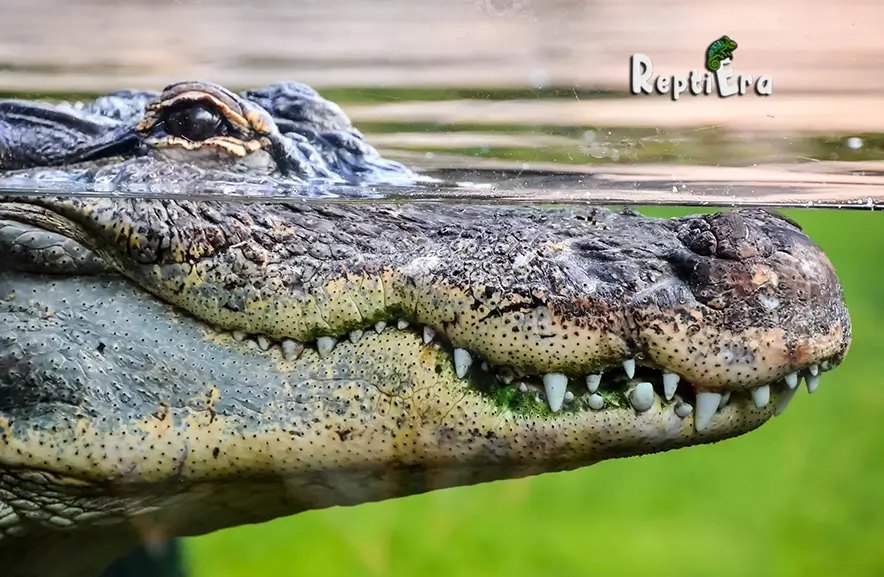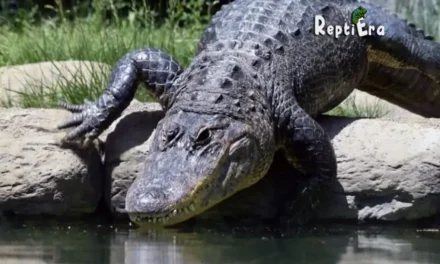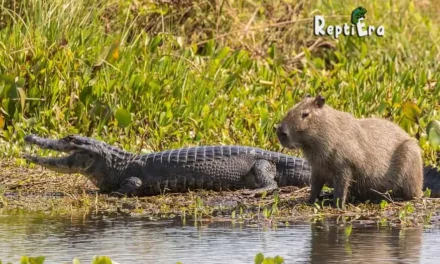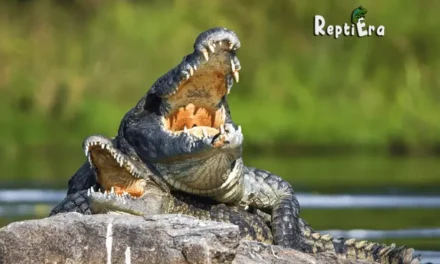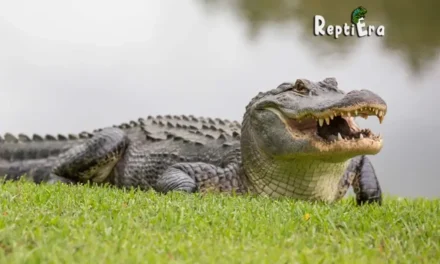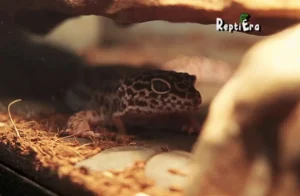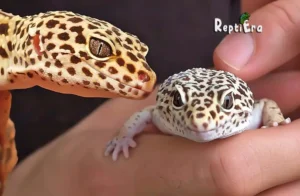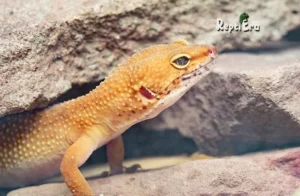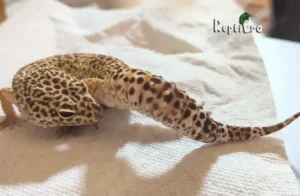Exploring the Crocodylia lineage that dates back 240 million years, it’s fascinating how often crocodiles and alligators are used interchangeably. Despite existing since the era of the dinosaurs, about 65 million years ago, many still confuse these massive creatures. While one might use alligator and crocodile interchangeably, the difference lies in the details of these large reptiles.
What Do Alligators And Crocodiles have in common?
Both share toothy grins and rough, bumpy skin; adaptations that enable them to thrive both on land and in water. However, the differences between a gator and their crocodile cousins extend beyond their families. The similarities they share, like long snouts, powerful tails, short legs, and bony-plated backs, set them apart from other species.
Crocodiles tend to have longer and thinner snouts compared to alligators. This distinction is vital for survival in both freshwater and saltwater environments. When it comes to teeth, alligators are usually invisible when their mouth is closed, becoming visible only when open.
In contrast, crocodile teeth remain visible, whether their mouth is open or closed. Despite these differences, their similarities are what have enabled these ancient reptiles to survive for millions of years, adapting to various ecological changes. Each time I see these majestic creatures, whether in the wild or in conservation areas, I’m reminded of their resilience and the crucial role they play in our planet’s biodiversity.
Table of Contents
Similarities between Alligators and Crocodiles
Here we show the main Differences between Alligators and Crocodiles and some Similarities.
| Crocodiles | Similarities | Alligators |
| In a closed mouth, both top & teeth are visible | Sharp Teeth | Skin Colour: Dark Gray or Black |
| Sensor pits all over the body | Long Tails | Scarcely skin |
| Narrow head and a long “V” shaped snout | Short legs | Wide head and wide ”U” shaped snout |
| Build a nest under the ground | Scarcely skin | In closed Mouth, only the top teeth are visible. |
| Lays about 50 eggs | Lays about 45 eggs | |
| Build a nest above the ground | Sensor pits only on the head |

Similarities Between Alligators and Crocodiles
Despite their differences, alligators and crocodiles share numerous physical similarities. Both have eyes located at the top of their heads, a strategic adaptation for spotting prey while mostly submerged underwater. Their vertical pupils can open wide, enhancing their ability to let in more light and improve night vision.
Additionally, both alligators and crocodiles are equipped with large, powerful tails that enable them to swiftly propel themselves through water. This combination of keen eyesight and muscular tails exemplifies their evolutionary adaptations, making them proficient hunters in their aquatic environments.
Alligators and crocodiles exhibit several features that help them excel as expert hunters. Both are adept at catching a variety of prey, ranging from fish to buffalo, showcasing the versatility of these reptiles. Their jaws and teeth are specialized for spearing, making it difficult for the captured prey to escape. Even small prey is not safe, as these predators can swallow them whole.
Unfortunately for their prey, both alligators and crocodiles have an unlimited supply of teeth and can regrow them if lost. This relentless ability to replace teeth ensures their prowess in hunting remains unhampered throughout their lives.
Differences Between Alligators and Crocodiles
Despite the long list of similarities that often leaves people wondering, there are notable differences between alligators and crocodiles. Although these two reptile groups are closely related in many categories, they diverge in several major aspects. Their distinctive features, behaviour, and habitat preferences underscore the diversity within the crocodilian family. These differences are crucial for their survival and adaptation in various ecosystems, reflecting the intricate balance of nature.
Also Read: DO ALLIGATORS EAT CAPYBARAS?
Snout and Jawline Shape
At a glance, many people believe that alligators and crocodiles have similar snouts, but the reality is quite different. Alligators possess a wider, U-shaped snout, unlike crocodiles which have a more pointed, V-shaped one. This difference is not just aesthetic; it influences how they capture and hold their prey. The razor-sharp teeth lining the jaws play a critical role in this process.
Another notable difference: is how the teeth are visible. In alligators, only the upper jaw teeth are visible when their mouths are open, as their lower jaw is wider and the teeth disappear when closed. In contrast, crocodiles show both sets of teeth, close and open, due to their jaws being of similar width, allowing their teeth to interlock. This distinct anatomical feature between these two reptiles is a key factor in their hunting tactics and diet preferences.
1- Size and Weight
There’s no doubt that both alligators and crocodiles are massive reptiles, but they significantly vary in size. The sizing of these creatures largely depends on the species. Generally, crocodiles have a tendency to grow larger than their alligator counterparts.
On average, an adult crocodile can reach up to approximately 19 feet in length, which is notably larger compared to an average adult alligator, which usually grows to about 14 feet long. This size difference not only affects their physical appearance but also influences their habitat, hunting methods, and overall survival strategies in the wild.
2- Skin
A noticeable difference between alligators and crocodiles lies in the colour and texture of their skin. Crocodiles typically have a lighter complexion, often tan or olive, whereas alligators tend to be darker, with black and grey shades. The shade of an alligator’s skin can change depending on its environment; they appears darker near overhanging trees due to tannic acid and greener in areas rich in algae.
Both possess unique sensory organs in the form of small pits, known as integumentary sensor organs (ISO), which play a crucial role in helping them locate prey by sensing pressure changes in water. These ISO appear as dots on their skin; however, their placement varies.
Crocodiles have these sensory organs covering the majority of their body, whereas alligators have them predominantly around their mouths. This difference in sensory adaptation is yet another fascinating aspect of these remarkable reptiles.
3- Reptiles
An obvious similarity between alligators and crocodiles is that these animals are both reptiles, embodying the quintessential traits of cold-blooded creatures. This means they expend little energy to move and regulate their internal body temperature using external heat sources like the sun.
Unlike mammals or other warm-blooded animals, both alligators and crocodiles are distinctly carnivorous in their eating habits, preferring a diet that underscores their predatory nature. Their tough, scaly hide not only serves as protective armour but also as a thermal regulator, absorbing heat when basking under the sun.
These majestic reptiles, with their ancient lineage, continue to fascinate and remind us of nature’s intricate and enduring design.
4- Habitat
Alligators and crocodiles are commonly known for living near water, with both being predominantly freshwater animals, although crocodiles can also thrive in saltwater. Their behaviour regarding habitat is similar; they both remain in areas like wetlands and coasts, which are essential for their survival. Surprisingly fast swimmers, these species are well-adapted to their aquatic habitats, which dictate their diet.
They predominantly eat other aquatic animals, such as fish and molluscs, showcasing their adaptability and prowess in these environments. This affinity for water-based ecosystems highlights the crucial role these ancient predators play in maintaining the ecological balance.
Related Post: DO ALLIGATORS GO IN SALTWATER
5- Diet
Both alligators and crocodiles, with their similar jaws and teeth size, tend to eat the same foods. Younger animals often feed on insects, crustaceans, and small fish, but as they grow bigger, their diet shifts to larger animals. They usually prefer to take one or two bites of their prey, which is considerably smaller than themselves, though occasionally, they do tackle larger animals.
This involves biting, dragging them underwater, and attempting to drown them. Generally, they are not dangerous to humans and tend to run away from people. However, if they feel aggressive or threatened, they might attack everything near them. This carnivorous diet is a fundamental aspect of th
6- Old Species
Alligators and crocodiles, pivotal members of the reptile animal family Crocodylidae, have existed relatively unchanged for about 55 million years. These formidable creatures share similar ancestors that first roamed the earth 200 million years ago, coexisting with the animals of the time of the dinosaurs.
Note: Despite the passing of aeons, they have undergone only small evolutionary changes since the species first appeared. This remarkable continuity showcases their resilience and adaptability, making them a living connection to a distant, prehistoric world. Their enduring presence is a testament to the effectiveness of their primal design in the relentless march of time.
7- Behavior
A major difference in behavioural patterns between alligators and crocodiles highlights their unique nature as reptiles. Despite being dangerous, their behaviour varies significantly.
Alligators are generally more timid and, when approached, have a tendency to escape rather than attack, unless they are provoked, unexpectedly disturbed, or defending their young. They are often more afraid of humans, but regular contact can cause them to lose this fear, leading to feeding behaviours where they may start viewing humans as a source of food, potentially mistaking small children and family pets as prey.
Crocodiles, on the other hand, are known to be bad-tempered and more likely to attack unprovoked. Nile and Australian saltwater crocodiles are among the most dangerous in the world, whereas American crocodiles are less aggressive. In America, being attacked by either is unlikely, and individuals are more likely to be killed by a shark than by these formidable reptiles.
Also Read: DO ALLIGATORS EAT EACH OTHER?
8- Location
In the United States, individuals are more likely to see an alligator than a crocodile, owing to a notably larger alligator population, estimated at approximately 3 million, compared to around 2,000 crocodiles. A key difference lies in their preferred habitat.
Crocodiles are often found in low-flowing rivers and grasslands across Africa, Australia, Southeast Asia, North America, South America, and Central America. They possess well-developed lingual salt glands, allowing them to expel excess salt and survive in saline water for weeks.
On the other hand, alligators are more common in China and the Southeastern part of the United States, including Florida and the Gulf Coast states. Their less developed lingual glands confine them primarily to freshwater habitats, such as marshes and slow-moving streams, though some can adapt to brackish water – a mixture of saltwater and freshwater.
Note: The only area in the world where both can be found living together is the Everglades, showcasing a unique coexistence in this diverse ecosystem.
Scientific Classification
| Common Name: | crocodile, croc; alligator, gator |
| Kingdom: | Animal |
| Phylum: | Chordata |
| Class: | Reptilian |
| Order: | Crocodilian |
| Family: | Crocodylidae (crocodiles), Alligatoridae (alligators) |
| Genus Species: | 23 living species |
Fun Facts
- Alligators and crocodiles rank among the oldest and most successful predators. A noteworthy extinct member of their family was the Deinosuchus, also known as the terrible crocodile. A fossil of this species was recovered in Texas, featuring a skull that measured over 2 meters (6.6 feet) in length. Researchers believe this enormous predator was about 15 meters (49 feet) long, making it large enough to eat dinosaurs of its time. This discovery highlights the incredible evolutionary journey and adaptability of these ancient reptiles.
- Crocodilians, such as the American alligator, are equipped with vertical pupils that open wide in low light, enhancing their prowess as impressive nocturnal hunters. Their unique throat (gular) pouch effectively blocks water while hunting, allowing them to eat prey both underwater and on land. This remarkable adaptation not only demonstrates their hunting efficiency but also their ability to thrive in diverse environments. Their anatomy is a testament to their evolutionary success in various habitats.
- The 23 living species of crocodilians have changed little in their appearance from their prehistoric relatives, despite being among the most advanced reptiles. Their evolutionary journey has seen them retain most of their ancestral traits. Notably, unlike most reptiles, crocodilians possess efficient four-chambered hearts, similar to those found in birds and mammals. This unique physiological feature underscores their adaptability and complex evolutionary history.
Ecology and Conservation
Crocodilians play a vital role in maintaining the overall health of ecosystems. For instance, the Nile crocodile (Crocodylus niloticus) helps control the barbel catfish population, preventing these voracious fish from wiping out other fish populations that serve as food sources for over 40 species of birds.
Their droppings also recycle nutrients back into the system, enhancing ecological balance. Moreover, crocodilians act as scavengers, feeding on dead carcasses found along waterways, thus cleansing the environment. Without them, many ecosystems would suffer significantly.
Their role extends beyond predation, contributing to the health and diversity of their habitats, making their conservation crucial for ecological stability.
FAQs
How are crocodiles and alligators similar?
Alligators and crocodiles both possess large, powerful tails, which assist them in swiftly propelling through water. These features help them to catch a variety of prey, earning them the reputation of being considered expert hunters. Their physical attributes and hunting skills highlight the similarities in their adaptation to aquatic life.
Who is the stronger alligator or the crocodile?
In a face-to-face combat, the crocodile would likely win over the alligator. The main reasons are that crocodiles are bigger and heavier, with a more lethal bite due to their greater size and strength, despite alligators being faster. This comparison highlights the physical prowess and dominance of crocodiles in the reptilian hierarchy.
What is the difference between alligator and crocodile teeth?
The primary distinction in dental structure is that True crocodiles have lower teeth that fit into notches on the side of their outer upper jaw, remaining protruding when their jaws are closed. Conversely, Alligators and caimans, with their broader snouts, have teeth that are not seen when closed, as their upper jaw teeth hang over the lower ones. This difference in tooth alignment is a key identifier between these two reptilian species.
Do crocodiles have 80 teeth?
Crocodiles have the unique ability as polyphyodonts to regenerate each of their 80 teeth potentially 50 times over their lifespan, which ranges from 35 to 75 years.
Why are crocodiles more aggressive than alligators?
While it’s advisable to avoid contact with both animals at all costs, alligators in the Everglades are comparatively more docile, typically only attacking if hungry or provoked. In contrast, crocodiles are known to attack more readily, often someone or something near them, and are generally more active in the water. This behavioural difference underscores the greater aggressiveness of crocodiles in their natural habitat.
Conclusion
In conclusion, the exploration into the world of alligators and crocodiles reveals a fascinating blend of similarities and differences. These ancient reptiles, sharing a lineage that dates back millions of years, exhibit remarkable physical traits and behavioural patterns that have allowed them to thrive in diverse ecosystems.
From their powerful tails and distinctive teeth to their varying levels of aggression and preferred habitats, alligators and crocodiles continue to captivate and intrigue. Understanding these aspects not only highlights the evolutionary marvels of these species but also underscores the importance of their conservation. As apex predators, their role in maintaining ecological balance is undeniable, making them crucial to the health of their respective environments.

